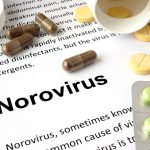 Norovirus and E. coli are two types of foodborne illnesses that are highly contagious. The two conditions can appear quite similar, so proper testing is important for narrowing down on the diagnosis.
Norovirus and E. coli are two types of foodborne illnesses that are highly contagious. The two conditions can appear quite similar, so proper testing is important for narrowing down on the diagnosis.
Here we will highlight the causes, symptoms, risk factors, and prevention tips for norovirus and E. coli.
Norovirus vs. E. coli: Previous outbreaks
Advertisement
This year so far has been quite abundant in norovirus and E. coli outbreaks affecting cruise ships, schools, restaurants, and even popular food companies. Here are some highlights of those many norovirus and E. coli incidences.
Back in late 2015, a Chipotle restaurant had an outbreak, which was confirmed to be caused by norovirus. Nearly 120 people became sick after eating at a Chipotle in Boston.
Earlier in 2015, Chipotle also had an E.coli outbreak, which led many who got sick during the later outbreak to believe that is what got to them. Based on symptoms of those who ate at Chipotle and patterns that experts identified, they confirmed that the illness was not E.coli related, but rather due to norovirus.
During inspection, Chipotle was asked to temporarily close after officials found that chicken was being kept at a too low temperature and that employees were working while clearly showing the signs of illness.
At a Seattle retirement home, a norovirus outbreak left dozens of people sick. Residents developed common norovirus symptoms, including vomiting, nausea, and diarrhea. Some had to be hospitalized due to old age.
After recommendations from health experts, facility members of the home immediately started disinfecting the entire building from wall to wall.
Nearly 60 students from the University of Rochester have been stricken with norovirus (stomach flu). Students have been experiencing vomiting, nausea, and diarrhea, and at least one student has a confirmed norovirus diagnosis.
Dining services are planning to temporarily suspend self-service operations. School officials are reporting that the source of virus is not the food itself, but rather the handling of shared utensils by numerous customers.
The school is undergoing extensive sanitization of the River Campus and Eastman School residential common areas and bathrooms.
 Twenty-eight students from the University of Minnesota residence hall have fallen ill from an unknown source within a short period of time. School officials are prompting for a thorough sanitization of dormitories and dining halls as a means to prevent further illness.
Twenty-eight students from the University of Minnesota residence hall have fallen ill from an unknown source within a short period of time. School officials are prompting for a thorough sanitization of dormitories and dining halls as a means to prevent further illness.
The suspected cause of the illness is norovirus, as symptoms experienced by the students were nausea, vomiting, and diarrhea. Health officials are interviewing students about what they ate in order to narrow down on a cause.
Nearly 260 passengers and crew members on board of a cruise ship the Balmoral – which was the first to board in Portland for the season – have become sick with norovirus. About 76 cruise ships are expected to port in Portland. This is the first one and it has already been hit with norovirus.
A city spokesperson Jessica Grondin said, “The reality is that many of the ships that come into port have cases of the norovirus (some more severe than others). It just doesn’t often get reported. The ship’s staff typically notifies our port security director upon arrival when there are large volumes of passengers with the virus.”
Although numerous passengers and crew had symptoms like vomiting, abdominal cramping, and diarrhea, only six passengers had to be quarantined. The cruise ship doesn’t quarantine guests just for 24 hours – which is recommended by the CDC – but for up to 48 hours, as this is the period after the recovery during which the person can still be contagious.
Crew members are utilizing stringent cleaning methods and are constantly wiping down all handles, railings, even elevators.
This year alone has already seen nine norovirus outbreaks on cruise ships. The CDC has implemented the Vessel Sanitation Program, which outlines protocol and procedures for sanitization and illness outbreaks. Based on the program, cruise ships must undergo at least two random inspections a year, especially the ships that are away from the U.S. for longer periods of time.
Over 270 people attending an event in Marshfield, central Wisconsin, have been potentially exposed to the norovirus. The Wood County Health Department is investigating the 16 cases of post-event illness and trying to uncover whether norovirus is the culprit. Those who have reported illness experienced symptoms common to norovirus such as vomiting, diarrhea, and stomach pains. Stool samples are being collected from those who have fallen ill, but it will take quite some time until results are back.
Another restaurant has been temporarily shut down due to norovirus, and it’s not another Chipotle location. This time around, it is the Applebee’s restaurant in Corunna, Michigan, where a person reported being sick after eating at this establishment. The Shiawassee County Health Department has confirmed norovirus as the cause. Unfortunately, the transmission source has yet to be identified.
A statement from the Personal Health Services Division read, “As of start of business day on March 22, 2016, a total of 30 people experienced similar symptoms and have contacted the Shiawassee County Health Department.”
Although the restaurant management has yet to comment on the outbreak, they are working closely with the health department in order to get the facility properly sanitized.
March 18, 2016, saw another norovirus outbreak at a senior living facility in Memphis, Tennessee. The Health Department is unsure about the exact number of residents who have fallen ill from norovirus, but it is considered an outbreak when over three individuals become ill.
Chief of epidemiology David Sweat said, “We got notification earlier this week there were some people ill. We sent a team out there to observe the situation and work with the facility staff. Limit communal gatherings, limit communal meals. You make sure to identify ill people who work there, exclude them from work while they’re ill, and you strengthen the hand-washing protocols.”
The use of hand sanitizer alone is not enough to stop the spread of norovirus, and soap and water must be utilized often in order to reduce the risk of transmission.
Officials from the residency did not make a comment, but the residents’ family and friends who went to visit them feel that they are handling the outbreak quite well and that their loved ones are recovering smoothly.
Norovirus vs. E. coli: U.S. Prevalence
 The CDC estimates that 19 to 21 million Americans become ill with norovirus, resulting in 56,000 to 71,000 hospitalizations and between 570 and 800 deaths annually. Because norovirus is so contagious, outbreaks can occur in a short time period, especially in close quarters like cruise ships and retirement homes.
The CDC estimates that 19 to 21 million Americans become ill with norovirus, resulting in 56,000 to 71,000 hospitalizations and between 570 and 800 deaths annually. Because norovirus is so contagious, outbreaks can occur in a short time period, especially in close quarters like cruise ships and retirement homes.
Between 1982 and 2002, there were 350 reported outbreaks of E. coli accounting for 8,598 cases of infection. Although advances in food production are on the rise, E. coli outbreaks are still regular and ground beef is the most common source of E. coli.
Comparing norovirus and E. coli signs and symptoms
Like many other foodborne illnesses, E. coli shares many common signs and symptoms that can make it difficult to narrow down on the diagnosis without laboratory testing. Signs and symptoms of E. coli include abdominal cramping, sudden, severe diarrhea, gas, loss of appetite, nausea, vomiting, fatigue, and fever.
Signs and symptoms of norovirus include vomiting, diarrhea, abdominal cramping, fever, chills, muscle aches, and nausea.
Norovirus and E. coli differences in causes and transmission
 Norovirus is the world’s most common foodborne illness, which can spread very quickly among populations. There are many reported norovirus outbreaks in areas where people reside closely together – such as schools, dorms, retirement facilities, and cruise ships. Norovirus is picked up by consuming contaminated food or water, or by being in close quarters with someone who is infected.
Norovirus is the world’s most common foodborne illness, which can spread very quickly among populations. There are many reported norovirus outbreaks in areas where people reside closely together – such as schools, dorms, retirement facilities, and cruise ships. Norovirus is picked up by consuming contaminated food or water, or by being in close quarters with someone who is infected.
E. coli is normally found in the intestines of both animals and humans, but only certain strains cause infection. Infection-causing strains can enter the body through improper handling of food, contamination caused during food processing, contaminated water, as well as person-to-person and animal contact.
E. coli vs. norovirus: Risk factors and complications
Risk factors for norovirus and E. coli are quite similar, as the contaminated food is the culprit or both. Food can become contaminated through improper handling, cooking, and storage.
Other risk factors that increase a person’s risk of contracting E. coli or norovirus include having a weakened or impaired immune system and living in areas where food is not processed properly.
Specific risk factors for E. coli illness include eating certain types of foods like hamburgers and soft cheeses made from raw milk, being a young child or older adult, and having decreased levels of stomach acid that can protect a person from E. coli infection.
Specific risk factors for norovirus include living with a child who attends preschool or daycare, living among others in close quarters like a nursing home, and staying in hotels, cruise ships, and other places of accommodation where many different groups of people from different places are present.
A serious that can arise from E. coli infection is hemolytic uremic syndrome, a life-threatening type of kidney failure. This complication is more often seen in younger children and older adults who do not receive treatment. In a healthy individual, the risk of E. coli complications is much lower.
The main complication from norovirus is dehydration. Symptoms of dehydration include fatigue, dry mouth and throat, dizziness, and a decrease in urine output.
Differentiating between E. coli and norovirus: Diagnosis and treatment
 Norovirus diagnosing involves an examination of symptoms, but the virus can be detected in a stool sample. Other than that, there are no specific diagnostic tests for norovirus. Oftentimes, unless the symptoms are severe, patients do not go in and see their doctor.
Norovirus diagnosing involves an examination of symptoms, but the virus can be detected in a stool sample. Other than that, there are no specific diagnostic tests for norovirus. Oftentimes, unless the symptoms are severe, patients do not go in and see their doctor.
Some medications can slow down diarrhea when it is really bad. As well, antibiotics are sometimes prescribed for certain types of bacteria.
If you are sick with norovirus, you can try the steps below to head down the road to recovery:
- Drink fluids throughout the day.
- Eat little amounts of food frequently, including salty foods.
- Eat foods that contain potassium, such as bananas.
- Only take medication if you have consulted with a doctor.
- If you can’t keep fluids down, seek medical attention.
- Get plenty of rest.
To diagnose E. coli, your doctor will send a stool sample off to a laboratory for analysis to determine the type of E. coli strain that you have contracted.
Similar to norovirus, there is no cure or other medications to ease symptoms. Therefore, you must just get plenty of rest and stay hydrated to prevent dehydration. You should avoid taking medications to prevent diarrhea as this will keep the toxins in the body.
E. coli and norovirus prevention tips
Norovirus is transmitted through the consumption of contaminated food or water, touching surfaces that are contaminated, or being around someone who is infected. A person with norovirus is most contagious when sick and even a few days after the symptoms have subsided.
Norovirus outbreaks commonly occur in settings where there are many people close together, such as cruise ships, daycare centers, retirement homes, dining halls, school dormitories, and hospitals.
Norovirus and E. coli are highly contagious, so it’s important that you take the necessary measures to prevent illness from either condition.
Here are some tips to keep in mind when trying to prevent norovirus and E. coli.
- Never forget to wash your hands well before handling food.
- Wash all fruits and vegetables thoroughly with a scrub brush.
- Use one cutting board for meat.
- Wash all cutting boards and utensils in hot, soapy water after use.
- Clean kitchen counters with bleach or disinfectant.
- Cook meats to a safe temperature to kill bacteria.
- Dispose of diapers properly so bacteria don’t spread.
- Wash your hands carefully after contact with someone who is ill.
Advertisement
E. coli is contracted through the consumption of contaminated food. There is currently no vaccine or medication that can protect you from E. coli, so other preventative measures must be practiced.
The best way to prevent E. coli transmission is by avoiding risky foods and unsafe preparation techniques. This means cooking foods at appropriate temperatures, storing foods at appropriate temperatures, properly cleaning raw produce, avoiding cross-contamination during the preparation process, keeping raw foods separate from each other, and frequently washing your hands. By following these safety tips, you can better reduce your risk of falling ill due to E. coli.
Sources:
